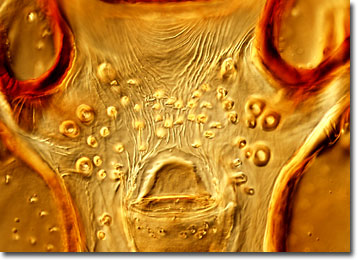Differential Interference Contrast Image Gallery
American Dog Tick (Dermacentor variabilis)
Despite its common name, the American dog tick may feed on a wide variety of hosts, including skunks, fox, cattle, raccoons, opossum, deer, squirrels, rabbits, chipmunks, and humans, in addition to canine species. The blood-sucking arachnids have four life stages, each of which must be accompanied by a blood meal in order for morphogenesis to take place.

The American dog tick is a member of the hard tick family Ixodidae. Hard ticks are responsible for transmitting nearly all of the major tick-borne diseases in North America. Though generally not believed to be vectors of Lyme disease, American dog ticks are the primary carriers of the Rocky Mountain spotted fever bacterium Rickettsia rickettsii. They are also capable of transmitting tularemia, Colorado tick fever, and anaplasmosis, and may cause paralysis when a neurotoxin they produce is secreted into a host's blood stream.
The secreted chemicals known as pheromones are extremely important to the American dog tick. When mature females find a suitable host, they utilize sex pheromones to attract a mate. Then, after the fertilized female has consumed her final blood meal, she drops off the host and lays her eggs on the ground before she dies. The six-legged nymphs that hatch from the eggs crawl up nearby vegetation and wait for an animal to pass by, using pheromones to detect potential hosts. Identifying a suitable host is crucial to the survival of the creatures, for without a blood meal they shortly perish. Then, even if the nymphs succeed in their quest for a host, new hosts must be located via pheromones in order successfully complete their lifecycle.
